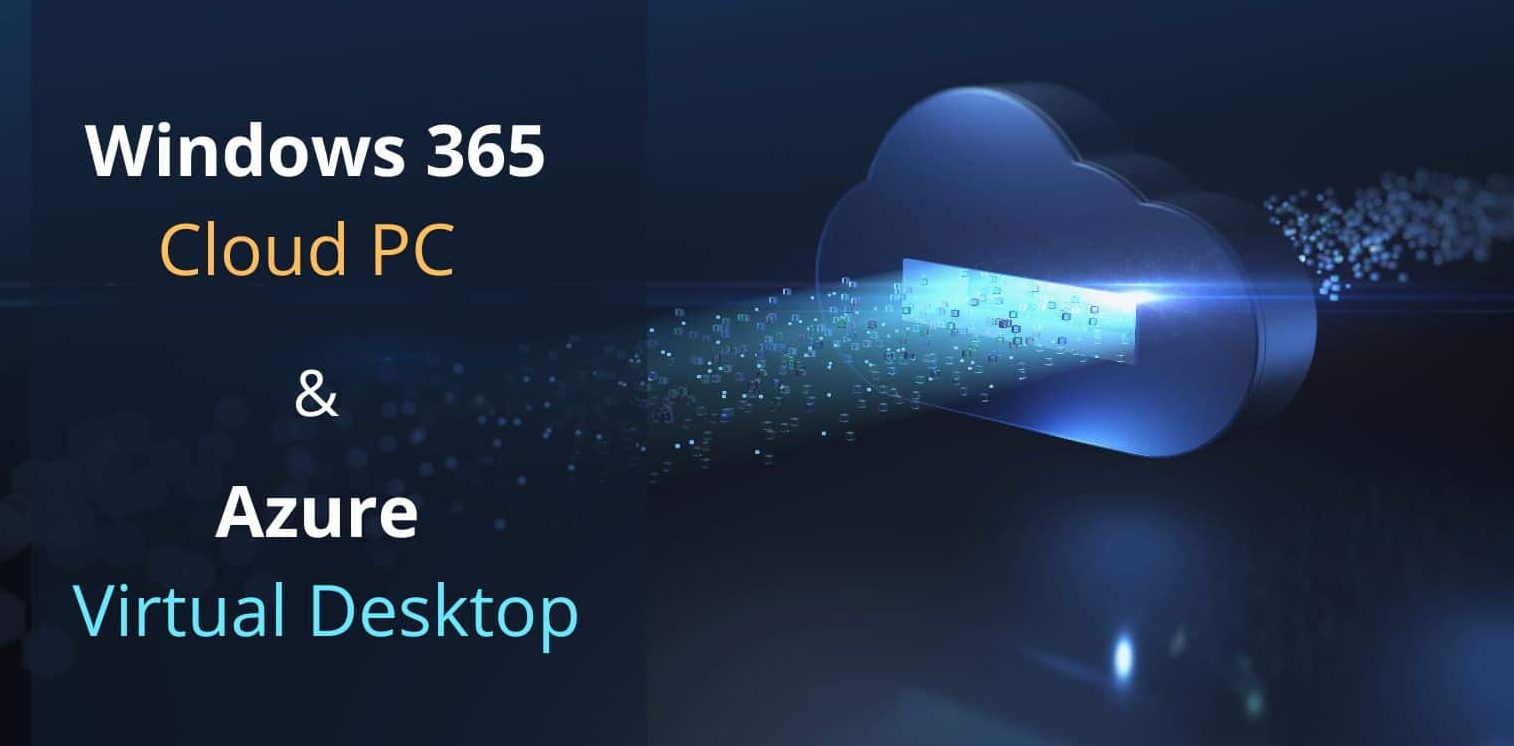Are you feeling overwhelmed with the many options for remote desktop solutions out there? Do you want to learn more about Windows 365 Cloud PC and how it compares to other solutions? Look no further, as we are here to explain everything you need to know about Windows 365 and how it differs from Azure Virtual Desktop.
First, let’s dive into what Windows 365 is. It’s a new cloud-based service that enables you to stream a virtualised Windows desktop from Microsoft Azure cloud infrastructure to any device with an internet connection. With this service, you can access your Windows desktop and all its applications, files, and settings from any device, including a PC, Mac, iPad, or Android tablet. This means you can work from anywhere, using any device without having to carry your physical computer with you.
When you subscribe to Windows 365, you will have access to a virtual machine (VM) running on the cloud that is dedicated to you. This means that you have your own isolated and secure environment that is not shared with other users. You can choose the size of the VM that best fits your needs, including the amount of CPU, memory, and storage.
Windows 365 is ideal for businesses and individuals who need to access their Windows desktop from different devices and locations. For example, if you work from home but need to access your work computer, you can use Windows 365 to stream your work desktop to your home PC or laptop. Similarly, if you are traveling and need to access your files, you can use Windows 365 to stream your desktop to your tablet or smartphone.
Regarding different needs of each business, there are two options of Windows 365:
W365 Enterprise and W365 Business
| Feature | Windows 365 Enterprise | Windows 365 Business |
| Target audience | Large organisations with complex IT environments and advanced security and compliance needs. | Small and medium-sized businesses (SMBs) that require a more straightforward virtual desktop solution. |
| Setup experience | Standard setup experience with Azure AD integration, Group Policy support, and advanced device management capabilities through Microsoft Endpoint Manager. | Simplified setup experience and management through the Microsoft 365 Admin Centre. |
| Customisation options | More advanced customisation options, including the ability to upload custom images and install custom software and applications. | Fewer customisation options for a simpler, more streamlined experience. |
| Management capabilities | Provides advanced device management capabilities through Microsoft Endpoint Manager. | Basic security and compliance features such as Microsoft Defender Antivirus and BitLocker encryption. |
| Pricing model | Monthly subscription per user, with different pricing tiers based on the amount of resources needed. | Available only as part of a Microsoft 365 Business Premium subscription, which includes additional features like Microsoft Office apps and Microsoft Teams. |
| Group Policy support | Yes | No |
| Resource customisation | Yes | No |
| Azure AD integration | Yes | Yes |
| Device management | Advanced device management capabilities through Microsoft Endpoint Manager. | Basic device management capabilities. |
| Security and compliance | Advanced security and compliance features. | Basic security and compliance features. |
| Advanced features | Provides more advanced capabilities for larger organisations with more complex needs. | Offers a simpler, more affordable solution for SMBs. |
| Office apps and Teams | Yes | Yes (as part of Microsoft 365 Business Premium subscription) |
WHAT IS AZURE VIRTUAL DESKTOP SOLUTION?
Alternatively, Azure Virtual Desktop is another Microsoft-provided service, similar to Windows 365. While both of these services offer virtual desktops, there are several key differences to keep in mind when deciding which one to use.
But overall, it allows users to access a virtualised Windows desktop and applications from any device, anywhere, as long as they have an internet connection. Azure Virtual Desktop is ideal for businesses of all sizes that need to provide remote access to their users.
With Azure Virtual Desktop, you can create virtual machines (VMs) in the cloud that can run Windows 10 or Windows Server, and you can configure these VMs to meet your specific needs, such as the amount of CPU, memory, and storage required. This allows you to create a custom environment for your users to access their virtual desktops and applications.
COMPARISON BETWEEN WINDOWS 365 AND AZURE VIRTUAL DESKTOP SOLUTION
Both Windows 365 and Azure Virtual Desktop are great options for businesses that need a virtual desktop solution. Windows 365 is generally less expensive and easier to use, making it a good option for businesses that want a simple, predictable solution. Azure Virtual Desktop provides more flexibility and customisation options, making it a good option for businesses that have more complex needs. Ultimately, the right choice depends on your business’s specific needs, budget, and technical expertise.
1-Subscription model
Windows 365 is a subscription-based service, meaning that businesses pay a fixed monthly fee for each user. This pricing model is predictable and allows businesses to plan their budgets accordingly. In contrast, Azure Virtual Desktop is priced based on usage, which can be difficult to predict and may result in unexpected costs.
2- Infrastructure management
One key difference between Windows 365 and Azure Virtual Desktop is the level of infrastructure management required.
With Windows 365, Microsoft manages the infrastructure and the software, making it a fully managed service. This means that businesses don’t need to worry about managing the underlying infrastructure, which can save time and resources. Azure Virtual Desktop, on the other hand, requires businesses to manage the virtual machines themselves, which can be more time-consuming and require more technical expertise.
3-Deployment
Another difference between the two services is the deployment process. Windows 365 is designed to be easy to deploy, with a simple setup process that allows businesses to create virtual desktops in just a few clicks. Azure Virtual Desktop, on the other hand, requires more configuration and setup, including the creation of virtual machines and the deployment of applications.
4-Scaling
Both Windows 365 and Azure Virtual Desktop are scalable solutions that can accommodate the needs of businesses of all sizes. However, Azure Virtual Desktop provides more flexibility when it comes to scaling, as businesses can add or remove virtual machines as needed based on their usage patterns. Windows 365, on the other hand, provides a fixed set of plans that may not be as flexible for businesses that have fluctuating needs.
5-Security
Both Windows 365 and Azure Virtual Desktop provide robust security features, including multi-factor authentication, network isolation, and data encryption. However, Windows 365 provides additional security features such as endpoint protection and security monitoring, making it a good option for businesses that prioritise security.
6-Cost
As mentioned earlier, Windows 365 is generally less expensive than Azure Virtual Desktop. Windows 365 is priced based on the size of the virtual machine and the amount of storage needed, with prices starting at $20 per user per month. Azure Virtual Desktop, on the other hand, is priced based on usage and requires businesses to pay for compute, storage, and networking resources separately. This can make it difficult to predict costs and may result in higher costs for businesses with fluctuating usage patterns.
7-Integration with Microsoft 365
Windows 365 is tightly integrated with Microsoft 365, making it easy for businesses to access and use their familiar Microsoft applications such as Word, Excel, PowerPoint, and Teams. This integration provides a seamless user experience for employees and allows businesses to maximise their investment in Microsoft 365. While Azure Virtual Desktop also supports Microsoft applications, businesses may need to configure and deploy them separately.
8-User profiles
Windows 365 provides user profiles that can be personalised for each user, allowing them to access their settings, applications, and files from any device. This feature provides a consistent user experience across devices and makes it easy for employees to work remotely. Azure Virtual Desktop also provides user profiles, but businesses may need to configure them manually.
9-Management tools
Windows 365 includes a web-based management portal that makes it easy for businesses to create and manage virtual desktops, assign users, and configure settings. This portal provides a simple, intuitive interface that requires minimal technical expertise. Azure Virtual Desktop provides management tools such as PowerShell scripts, APIs, and Azure Resource Manager templates, which may require more technical expertise to use.
10-Accessibility
Windows 365 is designed to be accessible for all users, including those with disabilities. The service meets accessibility standards such as the Web Content Accessibility Guidelines (WCAG) 2.0 and provides features such as high contrast mode and keyboard shortcuts for those who need them. Azure Virtual Desktop also supports accessibility features, but businesses may need to configure them manually.
11- Virtual machine options
Windows 365 provides a fixed set of virtual machine options that are designed to meet the needs of most businesses. These options range from basic to advanced and include different amounts of storage, RAM, and CPU cores. Azure Virtual Desktop provides more flexibility when it comes to virtual machine options, as businesses can choose from a wide range of options to meet their specific needs.
12-User experience
Both Windows 365 and Azure Virtual Desktop provide a good user experience, but Windows 365 is designed to be simpler and more intuitive. The service is easy to use and provides a familiar Windows environment that most users will be comfortable with. Azure Virtual Desktop can be more complex, especially for users who are not familiar with virtual desktops.
Overall difference between Windows 365 and Azure is shown as below. However, this table can change and may depend on your specific needs and use case.
| Feature | Windows 365 | Azure Virtual Desktop |
| Pricing | Starts at £28.80 per user/month | Pay-as-you-go, based on usage |
| Management | Fully managed by Microsoft | Requires more technical expertise |
| Deployment | Fully cloud-based | Can be deployed on-premises or in the cloud |
| Scalability | Limited scalability: up to 300 user profiles | High scalability: up to thousands of user profiles |
| Security | Microsoft-managed security and compliance | Businesses must configure security themselves |
| User experience | Simple and intuitive, similar to using a PC | Can be complex and may require training |
| Accessibility | Designed to meet accessibility standards | Requires manual configuration |
| Virtual machine options | Fixed set of options with up to 8 vCPUs and 32GB RAM | Wide range of options available with up to 96 vCPUs and 416GB RAM |
| Data residency | Depends on the chosen data centre region | Can choose specific data centre region |
| Hybrid deployment | Not currently available | Available with Azure Arc |
| Number of user profiles | Supports up to 300 user profiles per tenant | Supports thousands of user profiles per host pool |
The choice of a solution will vary based on your business’s specific goals and needs. If you’re interested in learning more about our W365 and Azure Virtual Desktop services, feel free to Contact one of Lucidica’s cloud specialists at Lucidica or Submit Form, we call you and talk you through your options to find the best fit for your needs!








